Consumer Insight Report: UK Female Fashion Marketing Strategies
VerifiedAdded on 2023/01/18
|12
|3954
|57
Report
AI Summary
This report provides a comprehensive analysis of the UK female fashion industry, focusing on consumer behavior and the factors that influence it. It begins by examining the macro influences, including economic conditions, sociocultural trends, technological advancements, and environmental concerns, and their impact on consumer purchasing decisions. The report then delves into micro influences, such as customer preferences, supplier relationships, and competitor activities, which shape the day-to-day operations of fashion businesses. Finally, it discusses the implications for shopper marketing within the UK female fashion sector, offering insights into how businesses can adapt their strategies to meet the evolving needs of consumers and maintain a competitive edge in the market. The report emphasizes the importance of understanding consumer behavior, adapting to technological changes, and addressing sustainability concerns to thrive in the dynamic fashion landscape.
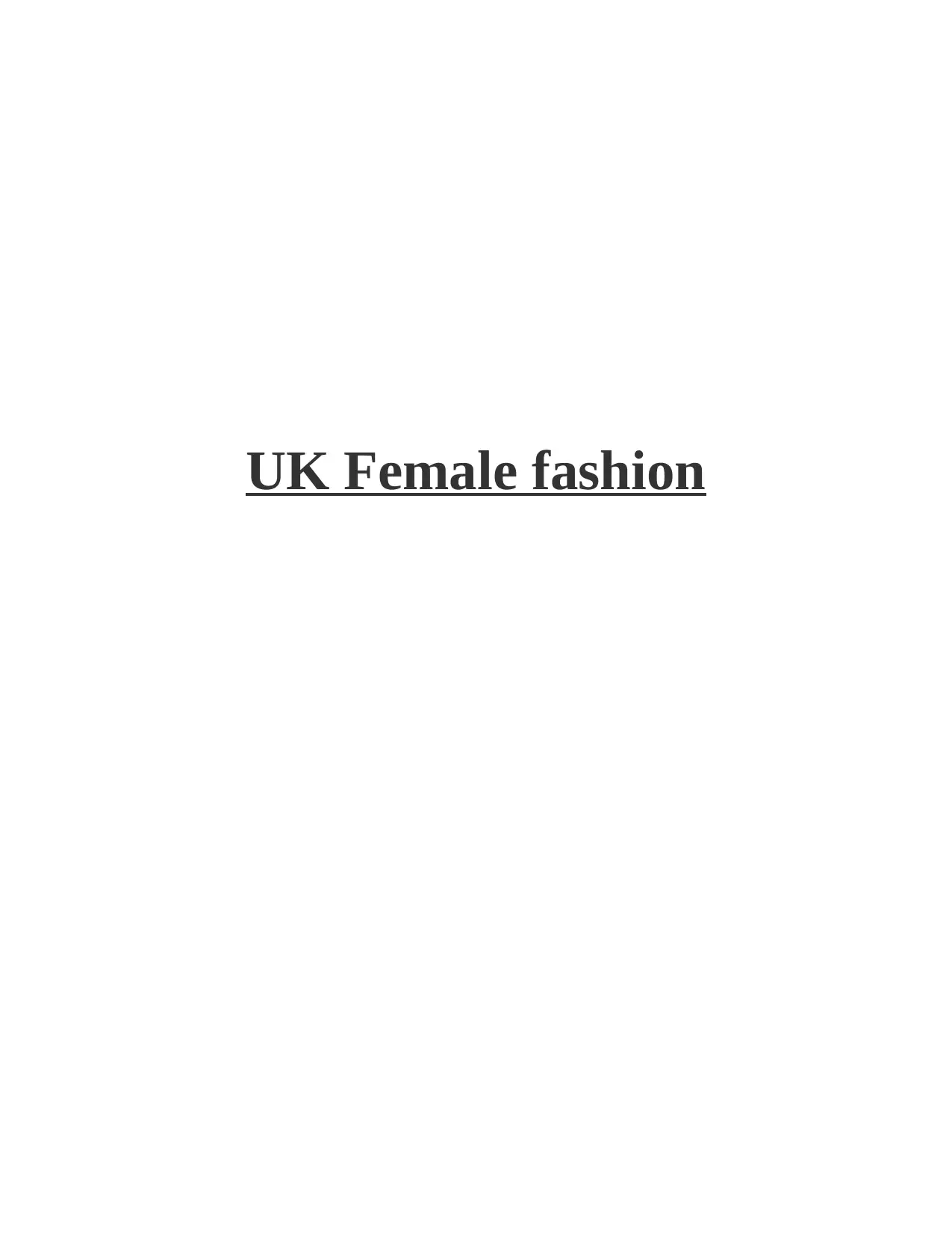
UK Female fashion
Paraphrase This Document
Need a fresh take? Get an instant paraphrase of this document with our AI Paraphraser
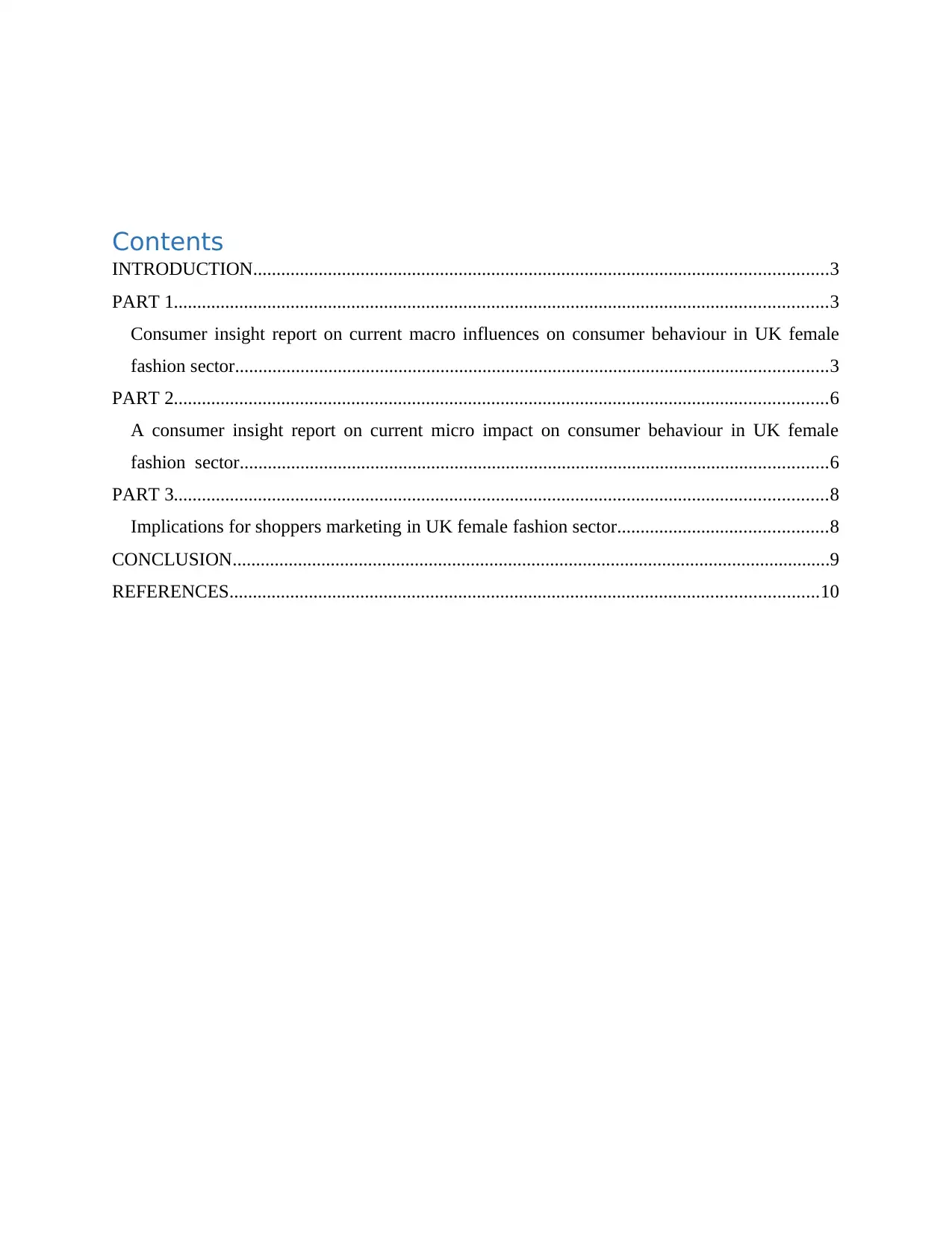
Contents
INTRODUCTION...........................................................................................................................3
PART 1............................................................................................................................................3
Consumer insight report on current macro influences on consumer behaviour in UK female
fashion sector...............................................................................................................................3
PART 2............................................................................................................................................6
A consumer insight report on current micro impact on consumer behaviour in UK female
fashion sector..............................................................................................................................6
PART 3............................................................................................................................................8
Implications for shoppers marketing in UK female fashion sector.............................................8
CONCLUSION................................................................................................................................9
REFERENCES..............................................................................................................................10
INTRODUCTION...........................................................................................................................3
PART 1............................................................................................................................................3
Consumer insight report on current macro influences on consumer behaviour in UK female
fashion sector...............................................................................................................................3
PART 2............................................................................................................................................6
A consumer insight report on current micro impact on consumer behaviour in UK female
fashion sector..............................................................................................................................6
PART 3............................................................................................................................................8
Implications for shoppers marketing in UK female fashion sector.............................................8
CONCLUSION................................................................................................................................9
REFERENCES..............................................................................................................................10
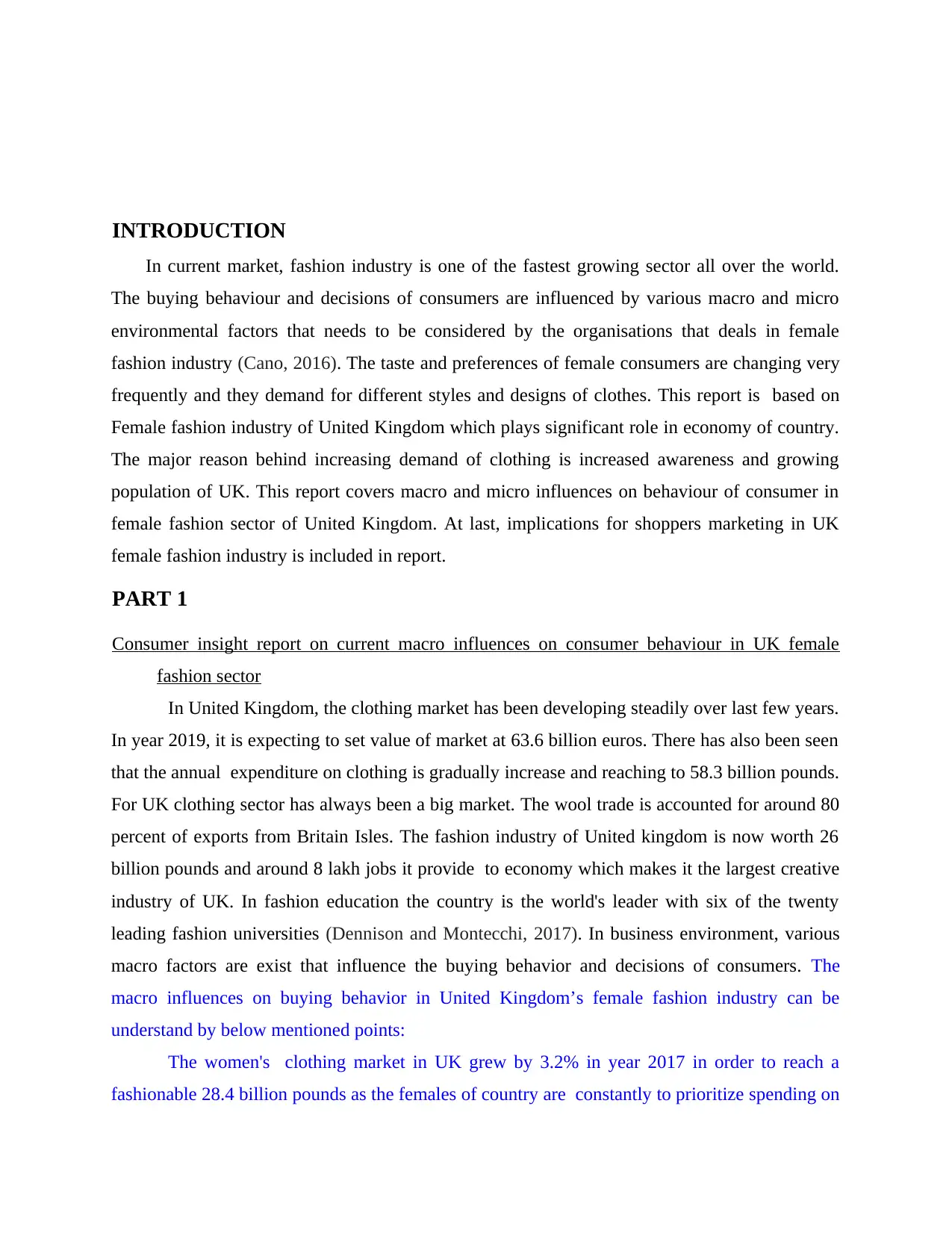
INTRODUCTION
In current market, fashion industry is one of the fastest growing sector all over the world.
The buying behaviour and decisions of consumers are influenced by various macro and micro
environmental factors that needs to be considered by the organisations that deals in female
fashion industry (Cano, 2016). The taste and preferences of female consumers are changing very
frequently and they demand for different styles and designs of clothes. This report is based on
Female fashion industry of United Kingdom which plays significant role in economy of country.
The major reason behind increasing demand of clothing is increased awareness and growing
population of UK. This report covers macro and micro influences on behaviour of consumer in
female fashion sector of United Kingdom. At last, implications for shoppers marketing in UK
female fashion industry is included in report.
PART 1
Consumer insight report on current macro influences on consumer behaviour in UK female
fashion sector
In United Kingdom, the clothing market has been developing steadily over last few years.
In year 2019, it is expecting to set value of market at 63.6 billion euros. There has also been seen
that the annual expenditure on clothing is gradually increase and reaching to 58.3 billion pounds.
For UK clothing sector has always been a big market. The wool trade is accounted for around 80
percent of exports from Britain Isles. The fashion industry of United kingdom is now worth 26
billion pounds and around 8 lakh jobs it provide to economy which makes it the largest creative
industry of UK. In fashion education the country is the world's leader with six of the twenty
leading fashion universities (Dennison and Montecchi, 2017). In business environment, various
macro factors are exist that influence the buying behavior and decisions of consumers. The
macro influences on buying behavior in United Kingdom’s female fashion industry can be
understand by below mentioned points:
The women's clothing market in UK grew by 3.2% in year 2017 in order to reach a
fashionable 28.4 billion pounds as the females of country are constantly to prioritize spending on
In current market, fashion industry is one of the fastest growing sector all over the world.
The buying behaviour and decisions of consumers are influenced by various macro and micro
environmental factors that needs to be considered by the organisations that deals in female
fashion industry (Cano, 2016). The taste and preferences of female consumers are changing very
frequently and they demand for different styles and designs of clothes. This report is based on
Female fashion industry of United Kingdom which plays significant role in economy of country.
The major reason behind increasing demand of clothing is increased awareness and growing
population of UK. This report covers macro and micro influences on behaviour of consumer in
female fashion sector of United Kingdom. At last, implications for shoppers marketing in UK
female fashion industry is included in report.
PART 1
Consumer insight report on current macro influences on consumer behaviour in UK female
fashion sector
In United Kingdom, the clothing market has been developing steadily over last few years.
In year 2019, it is expecting to set value of market at 63.6 billion euros. There has also been seen
that the annual expenditure on clothing is gradually increase and reaching to 58.3 billion pounds.
For UK clothing sector has always been a big market. The wool trade is accounted for around 80
percent of exports from Britain Isles. The fashion industry of United kingdom is now worth 26
billion pounds and around 8 lakh jobs it provide to economy which makes it the largest creative
industry of UK. In fashion education the country is the world's leader with six of the twenty
leading fashion universities (Dennison and Montecchi, 2017). In business environment, various
macro factors are exist that influence the buying behavior and decisions of consumers. The
macro influences on buying behavior in United Kingdom’s female fashion industry can be
understand by below mentioned points:
The women's clothing market in UK grew by 3.2% in year 2017 in order to reach a
fashionable 28.4 billion pounds as the females of country are constantly to prioritize spending on
⊘ This is a preview!⊘
Do you want full access?
Subscribe today to unlock all pages.

Trusted by 1+ million students worldwide
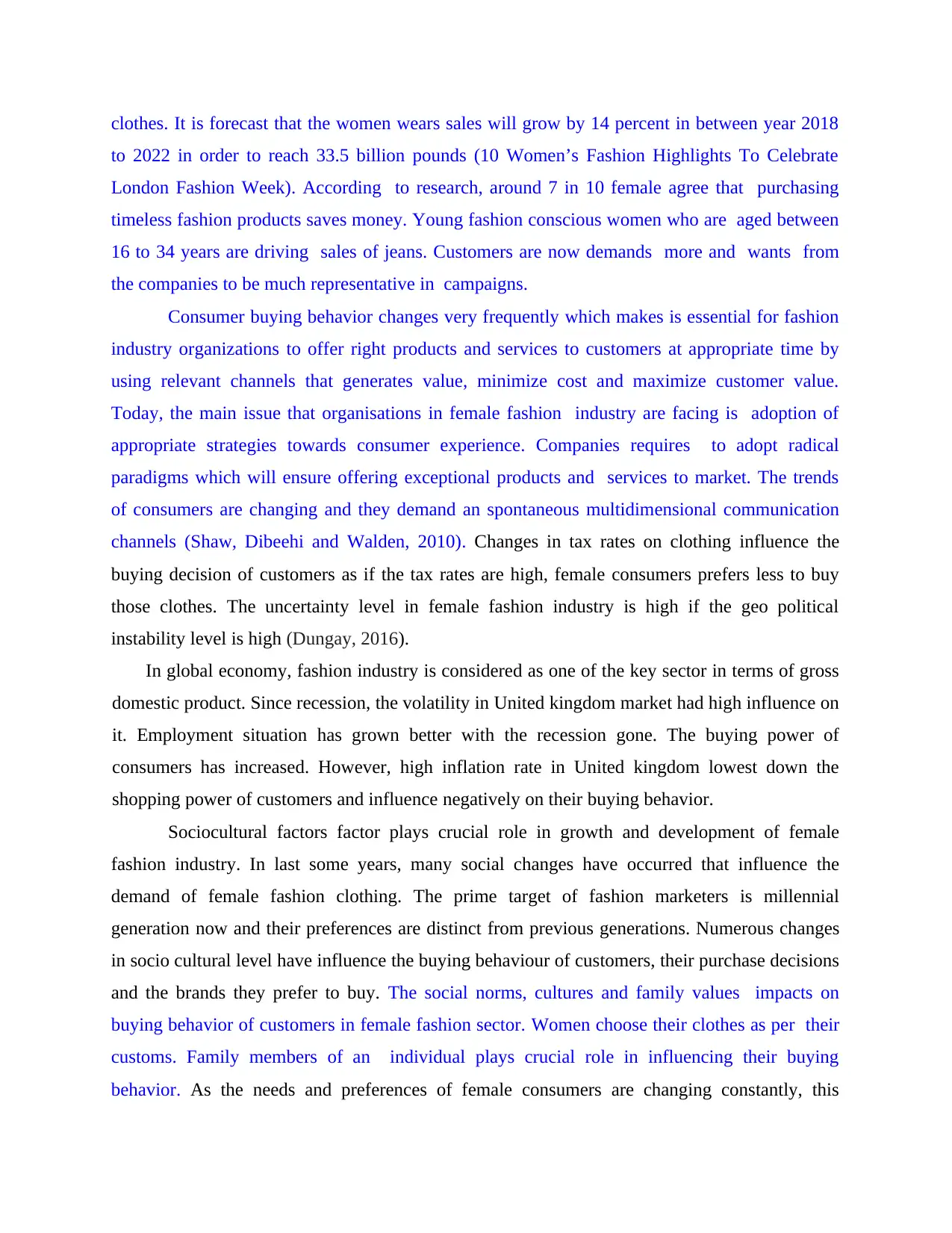
clothes. It is forecast that the women wears sales will grow by 14 percent in between year 2018
to 2022 in order to reach 33.5 billion pounds (10 Women’s Fashion Highlights To Celebrate
London Fashion Week). According to research, around 7 in 10 female agree that purchasing
timeless fashion products saves money. Young fashion conscious women who are aged between
16 to 34 years are driving sales of jeans. Customers are now demands more and wants from
the companies to be much representative in campaigns.
Consumer buying behavior changes very frequently which makes is essential for fashion
industry organizations to offer right products and services to customers at appropriate time by
using relevant channels that generates value, minimize cost and maximize customer value.
Today, the main issue that organisations in female fashion industry are facing is adoption of
appropriate strategies towards consumer experience. Companies requires to adopt radical
paradigms which will ensure offering exceptional products and services to market. The trends
of consumers are changing and they demand an spontaneous multidimensional communication
channels (Shaw, Dibeehi and Walden, 2010). Changes in tax rates on clothing influence the
buying decision of customers as if the tax rates are high, female consumers prefers less to buy
those clothes. The uncertainty level in female fashion industry is high if the geo political
instability level is high (Dungay, 2016).
In global economy, fashion industry is considered as one of the key sector in terms of gross
domestic product. Since recession, the volatility in United kingdom market had high influence on
it. Employment situation has grown better with the recession gone. The buying power of
consumers has increased. However, high inflation rate in United kingdom lowest down the
shopping power of customers and influence negatively on their buying behavior.
Sociocultural factors factor plays crucial role in growth and development of female
fashion industry. In last some years, many social changes have occurred that influence the
demand of female fashion clothing. The prime target of fashion marketers is millennial
generation now and their preferences are distinct from previous generations. Numerous changes
in socio cultural level have influence the buying behaviour of customers, their purchase decisions
and the brands they prefer to buy. The social norms, cultures and family values impacts on
buying behavior of customers in female fashion sector. Women choose their clothes as per their
customs. Family members of an individual plays crucial role in influencing their buying
behavior. As the needs and preferences of female consumers are changing constantly, this
to 2022 in order to reach 33.5 billion pounds (10 Women’s Fashion Highlights To Celebrate
London Fashion Week). According to research, around 7 in 10 female agree that purchasing
timeless fashion products saves money. Young fashion conscious women who are aged between
16 to 34 years are driving sales of jeans. Customers are now demands more and wants from
the companies to be much representative in campaigns.
Consumer buying behavior changes very frequently which makes is essential for fashion
industry organizations to offer right products and services to customers at appropriate time by
using relevant channels that generates value, minimize cost and maximize customer value.
Today, the main issue that organisations in female fashion industry are facing is adoption of
appropriate strategies towards consumer experience. Companies requires to adopt radical
paradigms which will ensure offering exceptional products and services to market. The trends
of consumers are changing and they demand an spontaneous multidimensional communication
channels (Shaw, Dibeehi and Walden, 2010). Changes in tax rates on clothing influence the
buying decision of customers as if the tax rates are high, female consumers prefers less to buy
those clothes. The uncertainty level in female fashion industry is high if the geo political
instability level is high (Dungay, 2016).
In global economy, fashion industry is considered as one of the key sector in terms of gross
domestic product. Since recession, the volatility in United kingdom market had high influence on
it. Employment situation has grown better with the recession gone. The buying power of
consumers has increased. However, high inflation rate in United kingdom lowest down the
shopping power of customers and influence negatively on their buying behavior.
Sociocultural factors factor plays crucial role in growth and development of female
fashion industry. In last some years, many social changes have occurred that influence the
demand of female fashion clothing. The prime target of fashion marketers is millennial
generation now and their preferences are distinct from previous generations. Numerous changes
in socio cultural level have influence the buying behaviour of customers, their purchase decisions
and the brands they prefer to buy. The social norms, cultures and family values impacts on
buying behavior of customers in female fashion sector. Women choose their clothes as per their
customs. Family members of an individual plays crucial role in influencing their buying
behavior. As the needs and preferences of female consumers are changing constantly, this
Paraphrase This Document
Need a fresh take? Get an instant paraphrase of this document with our AI Paraphraser
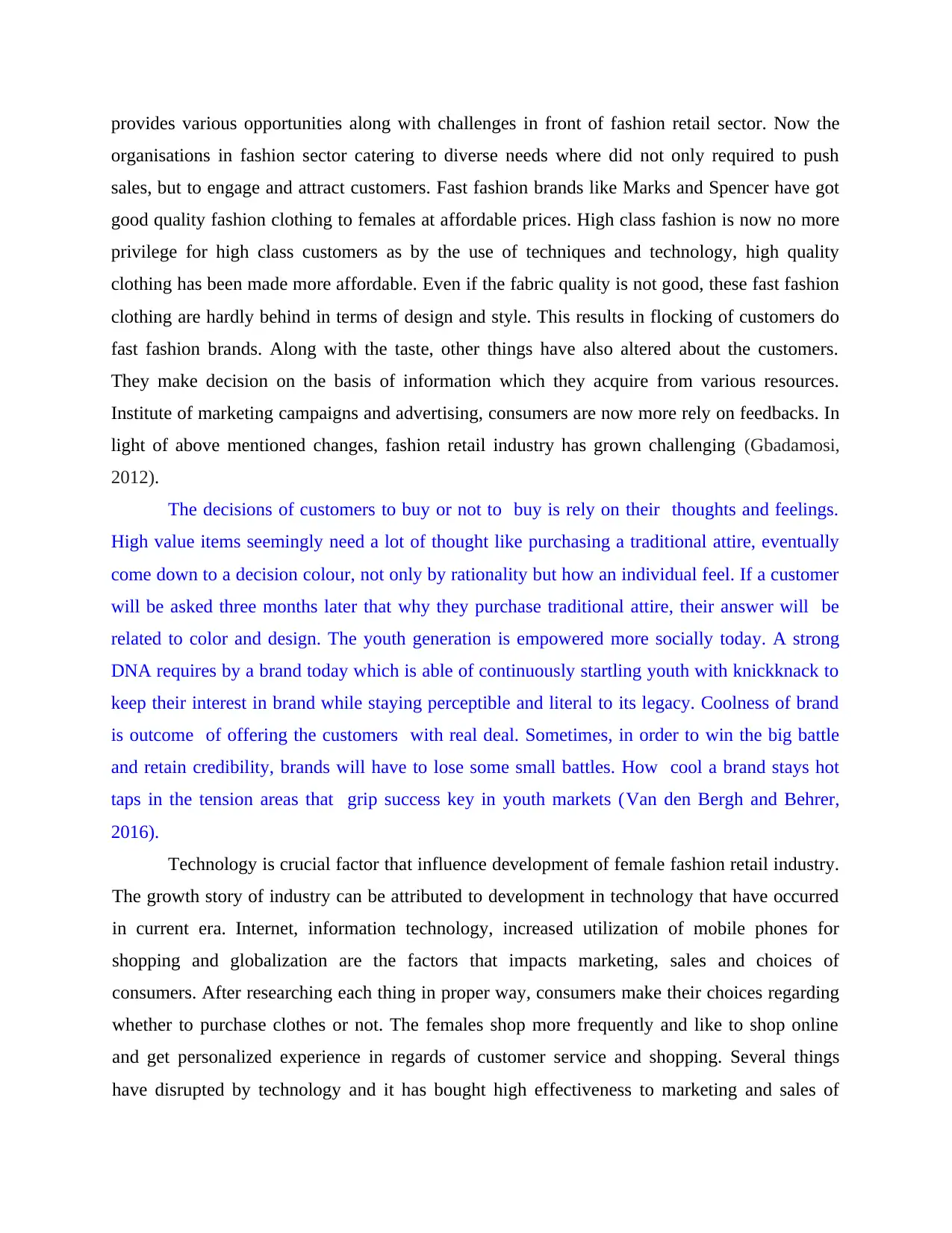
provides various opportunities along with challenges in front of fashion retail sector. Now the
organisations in fashion sector catering to diverse needs where did not only required to push
sales, but to engage and attract customers. Fast fashion brands like Marks and Spencer have got
good quality fashion clothing to females at affordable prices. High class fashion is now no more
privilege for high class customers as by the use of techniques and technology, high quality
clothing has been made more affordable. Even if the fabric quality is not good, these fast fashion
clothing are hardly behind in terms of design and style. This results in flocking of customers do
fast fashion brands. Along with the taste, other things have also altered about the customers.
They make decision on the basis of information which they acquire from various resources.
Institute of marketing campaigns and advertising, consumers are now more rely on feedbacks. In
light of above mentioned changes, fashion retail industry has grown challenging (Gbadamosi,
2012).
The decisions of customers to buy or not to buy is rely on their thoughts and feelings.
High value items seemingly need a lot of thought like purchasing a traditional attire, eventually
come down to a decision colour, not only by rationality but how an individual feel. If a customer
will be asked three months later that why they purchase traditional attire, their answer will be
related to color and design. The youth generation is empowered more socially today. A strong
DNA requires by a brand today which is able of continuously startling youth with knickknack to
keep their interest in brand while staying perceptible and literal to its legacy. Coolness of brand
is outcome of offering the customers with real deal. Sometimes, in order to win the big battle
and retain credibility, brands will have to lose some small battles. How cool a brand stays hot
taps in the tension areas that grip success key in youth markets (Van den Bergh and Behrer,
2016).
Technology is crucial factor that influence development of female fashion retail industry.
The growth story of industry can be attributed to development in technology that have occurred
in current era. Internet, information technology, increased utilization of mobile phones for
shopping and globalization are the factors that impacts marketing, sales and choices of
consumers. After researching each thing in proper way, consumers make their choices regarding
whether to purchase clothes or not. The females shop more frequently and like to shop online
and get personalized experience in regards of customer service and shopping. Several things
have disrupted by technology and it has bought high effectiveness to marketing and sales of
organisations in fashion sector catering to diverse needs where did not only required to push
sales, but to engage and attract customers. Fast fashion brands like Marks and Spencer have got
good quality fashion clothing to females at affordable prices. High class fashion is now no more
privilege for high class customers as by the use of techniques and technology, high quality
clothing has been made more affordable. Even if the fabric quality is not good, these fast fashion
clothing are hardly behind in terms of design and style. This results in flocking of customers do
fast fashion brands. Along with the taste, other things have also altered about the customers.
They make decision on the basis of information which they acquire from various resources.
Institute of marketing campaigns and advertising, consumers are now more rely on feedbacks. In
light of above mentioned changes, fashion retail industry has grown challenging (Gbadamosi,
2012).
The decisions of customers to buy or not to buy is rely on their thoughts and feelings.
High value items seemingly need a lot of thought like purchasing a traditional attire, eventually
come down to a decision colour, not only by rationality but how an individual feel. If a customer
will be asked three months later that why they purchase traditional attire, their answer will be
related to color and design. The youth generation is empowered more socially today. A strong
DNA requires by a brand today which is able of continuously startling youth with knickknack to
keep their interest in brand while staying perceptible and literal to its legacy. Coolness of brand
is outcome of offering the customers with real deal. Sometimes, in order to win the big battle
and retain credibility, brands will have to lose some small battles. How cool a brand stays hot
taps in the tension areas that grip success key in youth markets (Van den Bergh and Behrer,
2016).
Technology is crucial factor that influence development of female fashion retail industry.
The growth story of industry can be attributed to development in technology that have occurred
in current era. Internet, information technology, increased utilization of mobile phones for
shopping and globalization are the factors that impacts marketing, sales and choices of
consumers. After researching each thing in proper way, consumers make their choices regarding
whether to purchase clothes or not. The females shop more frequently and like to shop online
and get personalized experience in regards of customer service and shopping. Several things
have disrupted by technology and it has bought high effectiveness to marketing and sales of
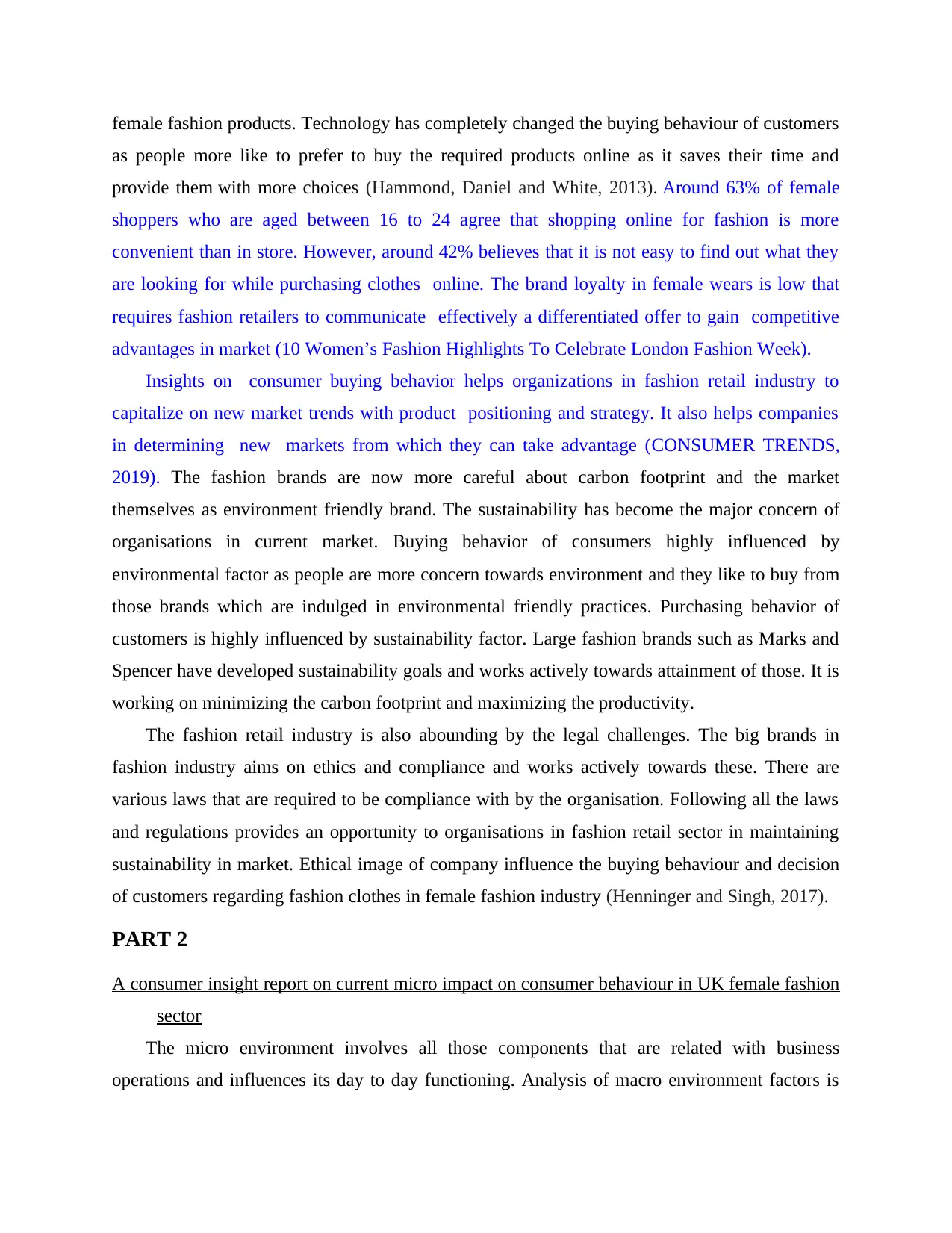
female fashion products. Technology has completely changed the buying behaviour of customers
as people more like to prefer to buy the required products online as it saves their time and
provide them with more choices (Hammond, Daniel and White, 2013). Around 63% of female
shoppers who are aged between 16 to 24 agree that shopping online for fashion is more
convenient than in store. However, around 42% believes that it is not easy to find out what they
are looking for while purchasing clothes online. The brand loyalty in female wears is low that
requires fashion retailers to communicate effectively a differentiated offer to gain competitive
advantages in market (10 Women’s Fashion Highlights To Celebrate London Fashion Week).
Insights on consumer buying behavior helps organizations in fashion retail industry to
capitalize on new market trends with product positioning and strategy. It also helps companies
in determining new markets from which they can take advantage (CONSUMER TRENDS,
2019). The fashion brands are now more careful about carbon footprint and the market
themselves as environment friendly brand. The sustainability has become the major concern of
organisations in current market. Buying behavior of consumers highly influenced by
environmental factor as people are more concern towards environment and they like to buy from
those brands which are indulged in environmental friendly practices. Purchasing behavior of
customers is highly influenced by sustainability factor. Large fashion brands such as Marks and
Spencer have developed sustainability goals and works actively towards attainment of those. It is
working on minimizing the carbon footprint and maximizing the productivity.
The fashion retail industry is also abounding by the legal challenges. The big brands in
fashion industry aims on ethics and compliance and works actively towards these. There are
various laws that are required to be compliance with by the organisation. Following all the laws
and regulations provides an opportunity to organisations in fashion retail sector in maintaining
sustainability in market. Ethical image of company influence the buying behaviour and decision
of customers regarding fashion clothes in female fashion industry (Henninger and Singh, 2017).
PART 2
A consumer insight report on current micro impact on consumer behaviour in UK female fashion
sector
The micro environment involves all those components that are related with business
operations and influences its day to day functioning. Analysis of macro environment factors is
as people more like to prefer to buy the required products online as it saves their time and
provide them with more choices (Hammond, Daniel and White, 2013). Around 63% of female
shoppers who are aged between 16 to 24 agree that shopping online for fashion is more
convenient than in store. However, around 42% believes that it is not easy to find out what they
are looking for while purchasing clothes online. The brand loyalty in female wears is low that
requires fashion retailers to communicate effectively a differentiated offer to gain competitive
advantages in market (10 Women’s Fashion Highlights To Celebrate London Fashion Week).
Insights on consumer buying behavior helps organizations in fashion retail industry to
capitalize on new market trends with product positioning and strategy. It also helps companies
in determining new markets from which they can take advantage (CONSUMER TRENDS,
2019). The fashion brands are now more careful about carbon footprint and the market
themselves as environment friendly brand. The sustainability has become the major concern of
organisations in current market. Buying behavior of consumers highly influenced by
environmental factor as people are more concern towards environment and they like to buy from
those brands which are indulged in environmental friendly practices. Purchasing behavior of
customers is highly influenced by sustainability factor. Large fashion brands such as Marks and
Spencer have developed sustainability goals and works actively towards attainment of those. It is
working on minimizing the carbon footprint and maximizing the productivity.
The fashion retail industry is also abounding by the legal challenges. The big brands in
fashion industry aims on ethics and compliance and works actively towards these. There are
various laws that are required to be compliance with by the organisation. Following all the laws
and regulations provides an opportunity to organisations in fashion retail sector in maintaining
sustainability in market. Ethical image of company influence the buying behaviour and decision
of customers regarding fashion clothes in female fashion industry (Henninger and Singh, 2017).
PART 2
A consumer insight report on current micro impact on consumer behaviour in UK female fashion
sector
The micro environment involves all those components that are related with business
operations and influences its day to day functioning. Analysis of macro environment factors is
⊘ This is a preview!⊘
Do you want full access?
Subscribe today to unlock all pages.

Trusted by 1+ million students worldwide
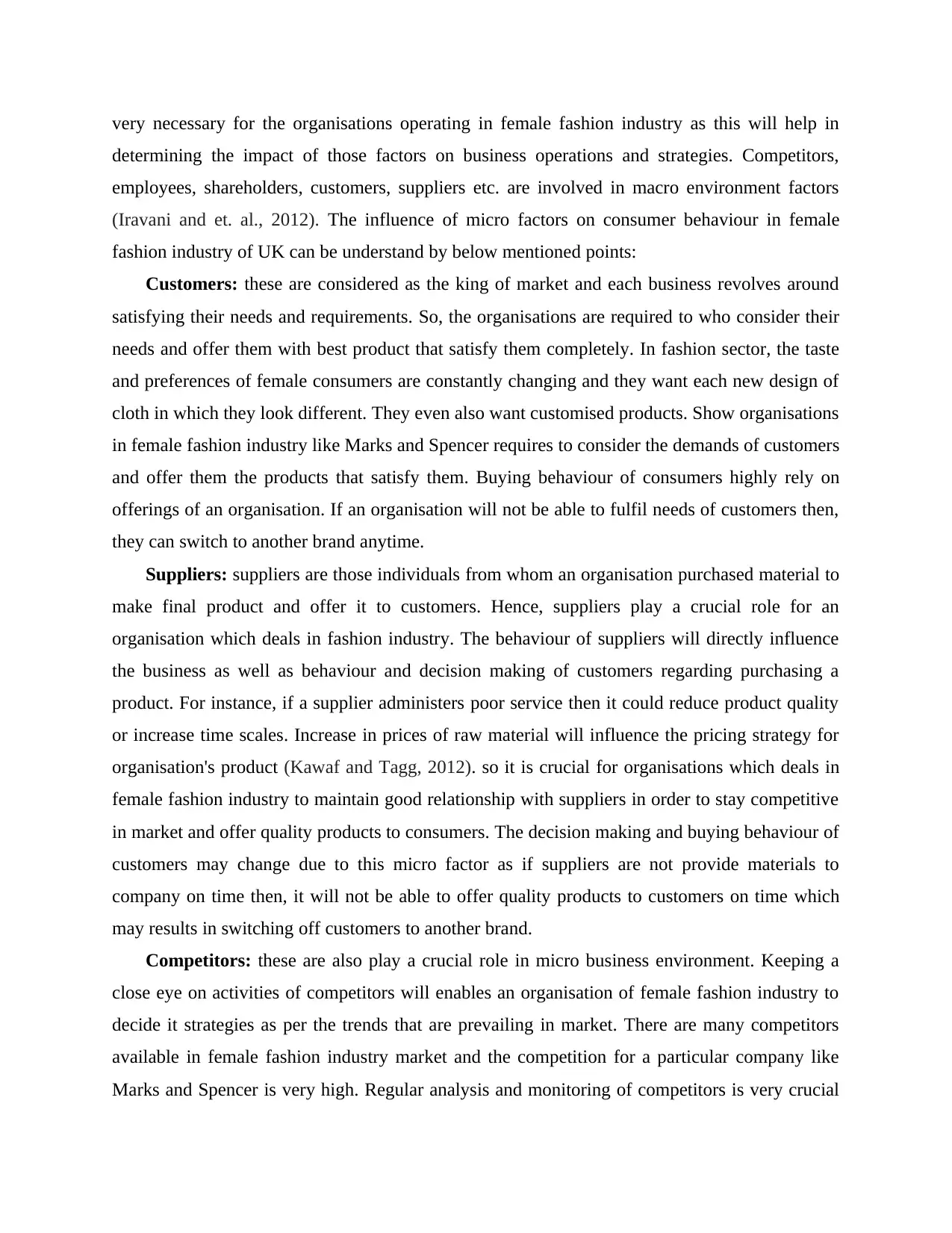
very necessary for the organisations operating in female fashion industry as this will help in
determining the impact of those factors on business operations and strategies. Competitors,
employees, shareholders, customers, suppliers etc. are involved in macro environment factors
(Iravani and et. al., 2012). The influence of micro factors on consumer behaviour in female
fashion industry of UK can be understand by below mentioned points:
Customers: these are considered as the king of market and each business revolves around
satisfying their needs and requirements. So, the organisations are required to who consider their
needs and offer them with best product that satisfy them completely. In fashion sector, the taste
and preferences of female consumers are constantly changing and they want each new design of
cloth in which they look different. They even also want customised products. Show organisations
in female fashion industry like Marks and Spencer requires to consider the demands of customers
and offer them the products that satisfy them. Buying behaviour of consumers highly rely on
offerings of an organisation. If an organisation will not be able to fulfil needs of customers then,
they can switch to another brand anytime.
Suppliers: suppliers are those individuals from whom an organisation purchased material to
make final product and offer it to customers. Hence, suppliers play a crucial role for an
organisation which deals in fashion industry. The behaviour of suppliers will directly influence
the business as well as behaviour and decision making of customers regarding purchasing a
product. For instance, if a supplier administers poor service then it could reduce product quality
or increase time scales. Increase in prices of raw material will influence the pricing strategy for
organisation's product (Kawaf and Tagg, 2012). so it is crucial for organisations which deals in
female fashion industry to maintain good relationship with suppliers in order to stay competitive
in market and offer quality products to consumers. The decision making and buying behaviour of
customers may change due to this micro factor as if suppliers are not provide materials to
company on time then, it will not be able to offer quality products to customers on time which
may results in switching off customers to another brand.
Competitors: these are also play a crucial role in micro business environment. Keeping a
close eye on activities of competitors will enables an organisation of female fashion industry to
decide it strategies as per the trends that are prevailing in market. There are many competitors
available in female fashion industry market and the competition for a particular company like
Marks and Spencer is very high. Regular analysis and monitoring of competitors is very crucial
determining the impact of those factors on business operations and strategies. Competitors,
employees, shareholders, customers, suppliers etc. are involved in macro environment factors
(Iravani and et. al., 2012). The influence of micro factors on consumer behaviour in female
fashion industry of UK can be understand by below mentioned points:
Customers: these are considered as the king of market and each business revolves around
satisfying their needs and requirements. So, the organisations are required to who consider their
needs and offer them with best product that satisfy them completely. In fashion sector, the taste
and preferences of female consumers are constantly changing and they want each new design of
cloth in which they look different. They even also want customised products. Show organisations
in female fashion industry like Marks and Spencer requires to consider the demands of customers
and offer them the products that satisfy them. Buying behaviour of consumers highly rely on
offerings of an organisation. If an organisation will not be able to fulfil needs of customers then,
they can switch to another brand anytime.
Suppliers: suppliers are those individuals from whom an organisation purchased material to
make final product and offer it to customers. Hence, suppliers play a crucial role for an
organisation which deals in fashion industry. The behaviour of suppliers will directly influence
the business as well as behaviour and decision making of customers regarding purchasing a
product. For instance, if a supplier administers poor service then it could reduce product quality
or increase time scales. Increase in prices of raw material will influence the pricing strategy for
organisation's product (Kawaf and Tagg, 2012). so it is crucial for organisations which deals in
female fashion industry to maintain good relationship with suppliers in order to stay competitive
in market and offer quality products to consumers. The decision making and buying behaviour of
customers may change due to this micro factor as if suppliers are not provide materials to
company on time then, it will not be able to offer quality products to customers on time which
may results in switching off customers to another brand.
Competitors: these are also play a crucial role in micro business environment. Keeping a
close eye on activities of competitors will enables an organisation of female fashion industry to
decide it strategies as per the trends that are prevailing in market. There are many competitors
available in female fashion industry market and the competition for a particular company like
Marks and Spencer is very high. Regular analysis and monitoring of competitors is very crucial
Paraphrase This Document
Need a fresh take? Get an instant paraphrase of this document with our AI Paraphraser
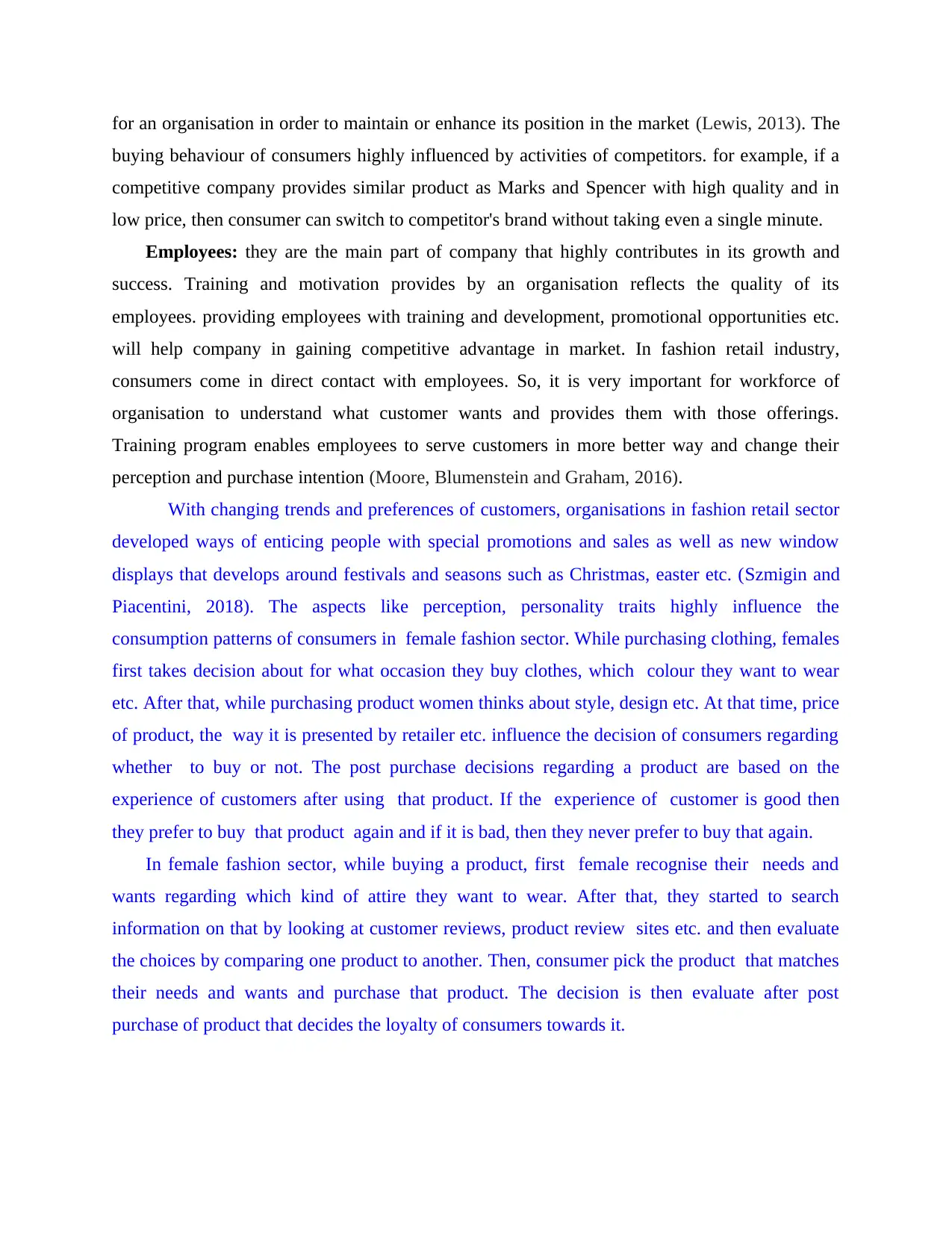
for an organisation in order to maintain or enhance its position in the market (Lewis, 2013). The
buying behaviour of consumers highly influenced by activities of competitors. for example, if a
competitive company provides similar product as Marks and Spencer with high quality and in
low price, then consumer can switch to competitor's brand without taking even a single minute.
Employees: they are the main part of company that highly contributes in its growth and
success. Training and motivation provides by an organisation reflects the quality of its
employees. providing employees with training and development, promotional opportunities etc.
will help company in gaining competitive advantage in market. In fashion retail industry,
consumers come in direct contact with employees. So, it is very important for workforce of
organisation to understand what customer wants and provides them with those offerings.
Training program enables employees to serve customers in more better way and change their
perception and purchase intention (Moore, Blumenstein and Graham, 2016).
With changing trends and preferences of customers, organisations in fashion retail sector
developed ways of enticing people with special promotions and sales as well as new window
displays that develops around festivals and seasons such as Christmas, easter etc. (Szmigin and
Piacentini, 2018). The aspects like perception, personality traits highly influence the
consumption patterns of consumers in female fashion sector. While purchasing clothing, females
first takes decision about for what occasion they buy clothes, which colour they want to wear
etc. After that, while purchasing product women thinks about style, design etc. At that time, price
of product, the way it is presented by retailer etc. influence the decision of consumers regarding
whether to buy or not. The post purchase decisions regarding a product are based on the
experience of customers after using that product. If the experience of customer is good then
they prefer to buy that product again and if it is bad, then they never prefer to buy that again.
In female fashion sector, while buying a product, first female recognise their needs and
wants regarding which kind of attire they want to wear. After that, they started to search
information on that by looking at customer reviews, product review sites etc. and then evaluate
the choices by comparing one product to another. Then, consumer pick the product that matches
their needs and wants and purchase that product. The decision is then evaluate after post
purchase of product that decides the loyalty of consumers towards it.
buying behaviour of consumers highly influenced by activities of competitors. for example, if a
competitive company provides similar product as Marks and Spencer with high quality and in
low price, then consumer can switch to competitor's brand without taking even a single minute.
Employees: they are the main part of company that highly contributes in its growth and
success. Training and motivation provides by an organisation reflects the quality of its
employees. providing employees with training and development, promotional opportunities etc.
will help company in gaining competitive advantage in market. In fashion retail industry,
consumers come in direct contact with employees. So, it is very important for workforce of
organisation to understand what customer wants and provides them with those offerings.
Training program enables employees to serve customers in more better way and change their
perception and purchase intention (Moore, Blumenstein and Graham, 2016).
With changing trends and preferences of customers, organisations in fashion retail sector
developed ways of enticing people with special promotions and sales as well as new window
displays that develops around festivals and seasons such as Christmas, easter etc. (Szmigin and
Piacentini, 2018). The aspects like perception, personality traits highly influence the
consumption patterns of consumers in female fashion sector. While purchasing clothing, females
first takes decision about for what occasion they buy clothes, which colour they want to wear
etc. After that, while purchasing product women thinks about style, design etc. At that time, price
of product, the way it is presented by retailer etc. influence the decision of consumers regarding
whether to buy or not. The post purchase decisions regarding a product are based on the
experience of customers after using that product. If the experience of customer is good then
they prefer to buy that product again and if it is bad, then they never prefer to buy that again.
In female fashion sector, while buying a product, first female recognise their needs and
wants regarding which kind of attire they want to wear. After that, they started to search
information on that by looking at customer reviews, product review sites etc. and then evaluate
the choices by comparing one product to another. Then, consumer pick the product that matches
their needs and wants and purchase that product. The decision is then evaluate after post
purchase of product that decides the loyalty of consumers towards it.
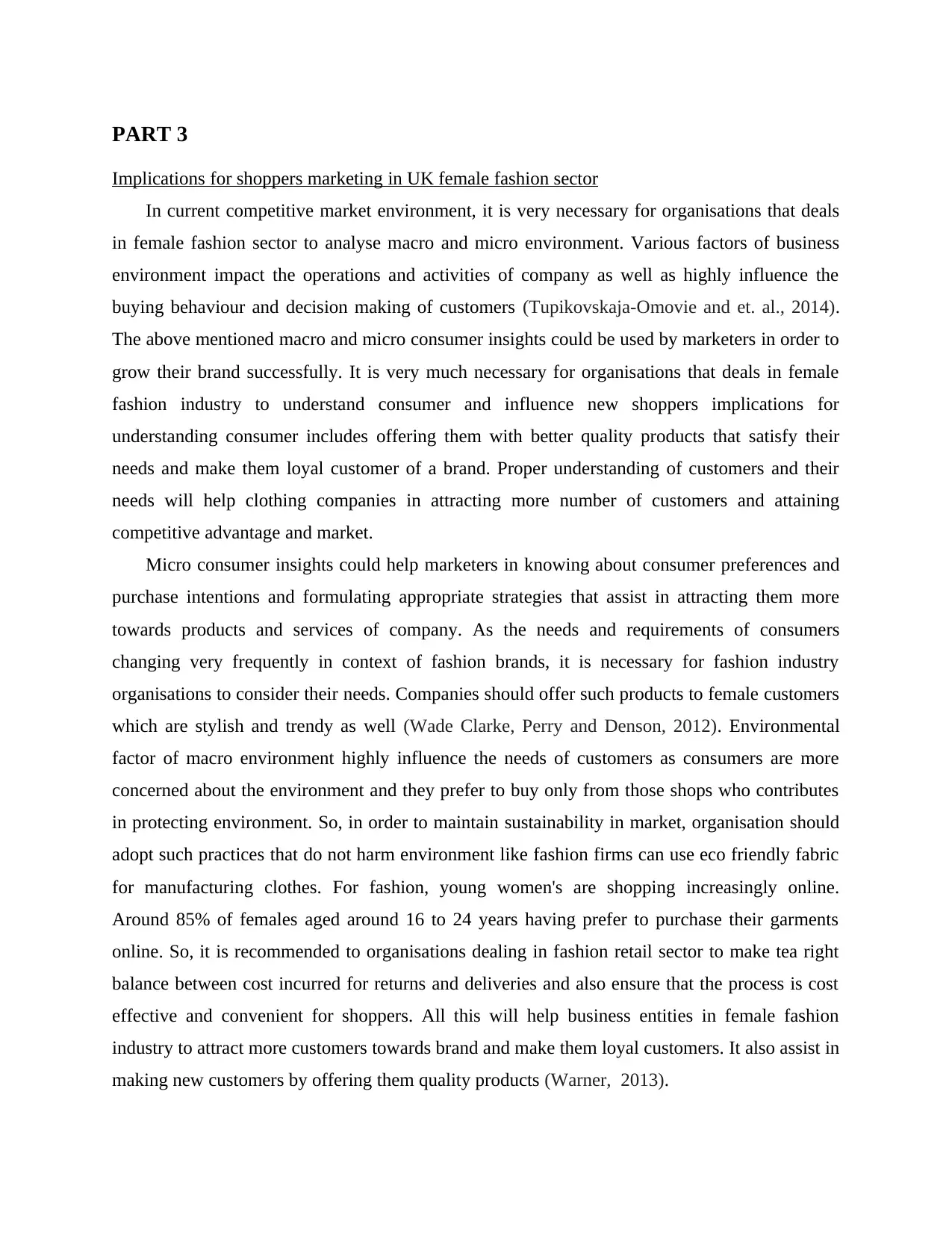
PART 3
Implications for shoppers marketing in UK female fashion sector
In current competitive market environment, it is very necessary for organisations that deals
in female fashion sector to analyse macro and micro environment. Various factors of business
environment impact the operations and activities of company as well as highly influence the
buying behaviour and decision making of customers (Tupikovskaja-Omovie and et. al., 2014).
The above mentioned macro and micro consumer insights could be used by marketers in order to
grow their brand successfully. It is very much necessary for organisations that deals in female
fashion industry to understand consumer and influence new shoppers implications for
understanding consumer includes offering them with better quality products that satisfy their
needs and make them loyal customer of a brand. Proper understanding of customers and their
needs will help clothing companies in attracting more number of customers and attaining
competitive advantage and market.
Micro consumer insights could help marketers in knowing about consumer preferences and
purchase intentions and formulating appropriate strategies that assist in attracting them more
towards products and services of company. As the needs and requirements of consumers
changing very frequently in context of fashion brands, it is necessary for fashion industry
organisations to consider their needs. Companies should offer such products to female customers
which are stylish and trendy as well (Wade Clarke, Perry and Denson, 2012). Environmental
factor of macro environment highly influence the needs of customers as consumers are more
concerned about the environment and they prefer to buy only from those shops who contributes
in protecting environment. So, in order to maintain sustainability in market, organisation should
adopt such practices that do not harm environment like fashion firms can use eco friendly fabric
for manufacturing clothes. For fashion, young women's are shopping increasingly online.
Around 85% of females aged around 16 to 24 years having prefer to purchase their garments
online. So, it is recommended to organisations dealing in fashion retail sector to make tea right
balance between cost incurred for returns and deliveries and also ensure that the process is cost
effective and convenient for shoppers. All this will help business entities in female fashion
industry to attract more customers towards brand and make them loyal customers. It also assist in
making new customers by offering them quality products (Warner, 2013).
Implications for shoppers marketing in UK female fashion sector
In current competitive market environment, it is very necessary for organisations that deals
in female fashion sector to analyse macro and micro environment. Various factors of business
environment impact the operations and activities of company as well as highly influence the
buying behaviour and decision making of customers (Tupikovskaja-Omovie and et. al., 2014).
The above mentioned macro and micro consumer insights could be used by marketers in order to
grow their brand successfully. It is very much necessary for organisations that deals in female
fashion industry to understand consumer and influence new shoppers implications for
understanding consumer includes offering them with better quality products that satisfy their
needs and make them loyal customer of a brand. Proper understanding of customers and their
needs will help clothing companies in attracting more number of customers and attaining
competitive advantage and market.
Micro consumer insights could help marketers in knowing about consumer preferences and
purchase intentions and formulating appropriate strategies that assist in attracting them more
towards products and services of company. As the needs and requirements of consumers
changing very frequently in context of fashion brands, it is necessary for fashion industry
organisations to consider their needs. Companies should offer such products to female customers
which are stylish and trendy as well (Wade Clarke, Perry and Denson, 2012). Environmental
factor of macro environment highly influence the needs of customers as consumers are more
concerned about the environment and they prefer to buy only from those shops who contributes
in protecting environment. So, in order to maintain sustainability in market, organisation should
adopt such practices that do not harm environment like fashion firms can use eco friendly fabric
for manufacturing clothes. For fashion, young women's are shopping increasingly online.
Around 85% of females aged around 16 to 24 years having prefer to purchase their garments
online. So, it is recommended to organisations dealing in fashion retail sector to make tea right
balance between cost incurred for returns and deliveries and also ensure that the process is cost
effective and convenient for shoppers. All this will help business entities in female fashion
industry to attract more customers towards brand and make them loyal customers. It also assist in
making new customers by offering them quality products (Warner, 2013).
⊘ This is a preview!⊘
Do you want full access?
Subscribe today to unlock all pages.

Trusted by 1+ million students worldwide
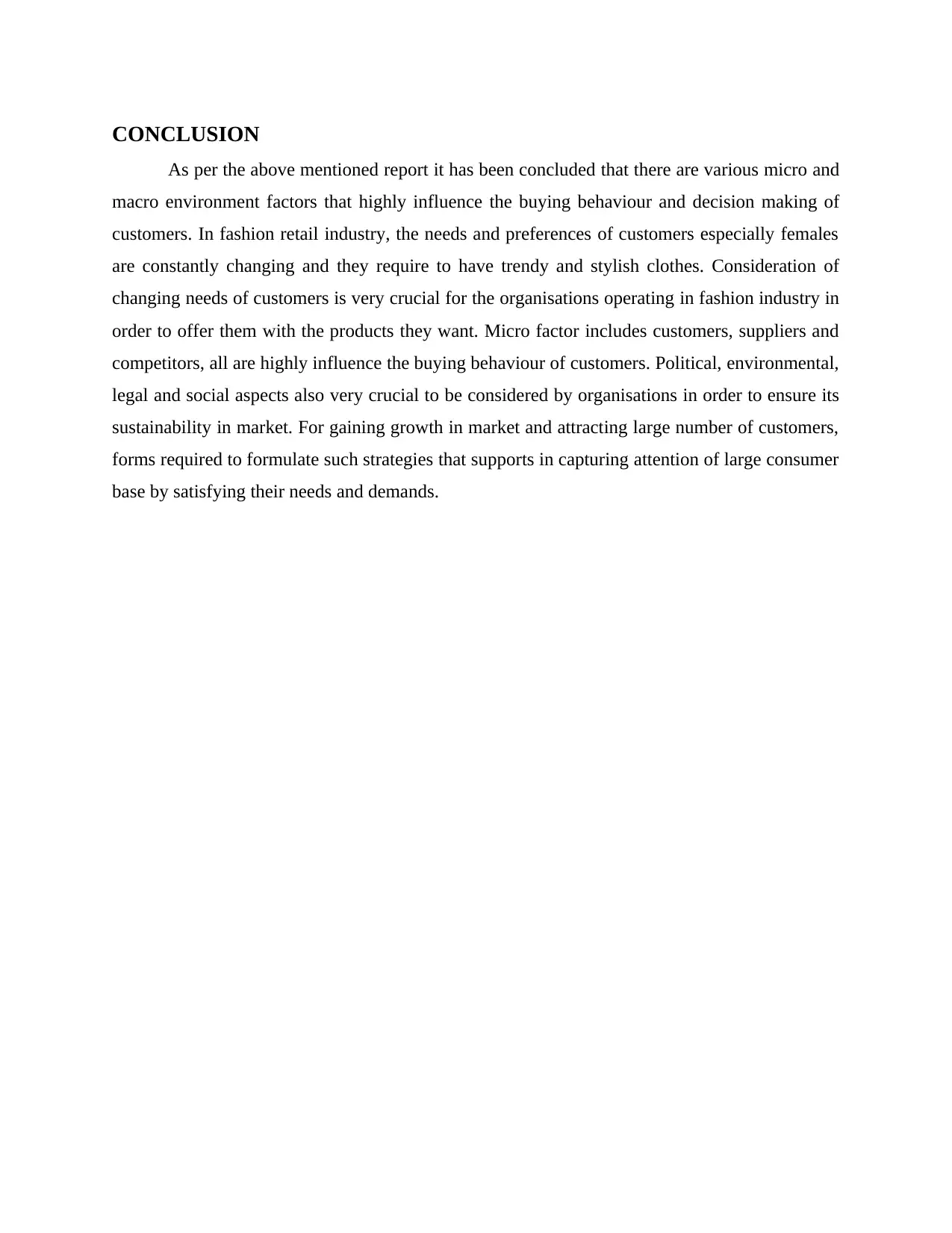
CONCLUSION
As per the above mentioned report it has been concluded that there are various micro and
macro environment factors that highly influence the buying behaviour and decision making of
customers. In fashion retail industry, the needs and preferences of customers especially females
are constantly changing and they require to have trendy and stylish clothes. Consideration of
changing needs of customers is very crucial for the organisations operating in fashion industry in
order to offer them with the products they want. Micro factor includes customers, suppliers and
competitors, all are highly influence the buying behaviour of customers. Political, environmental,
legal and social aspects also very crucial to be considered by organisations in order to ensure its
sustainability in market. For gaining growth in market and attracting large number of customers,
forms required to formulate such strategies that supports in capturing attention of large consumer
base by satisfying their needs and demands.
As per the above mentioned report it has been concluded that there are various micro and
macro environment factors that highly influence the buying behaviour and decision making of
customers. In fashion retail industry, the needs and preferences of customers especially females
are constantly changing and they require to have trendy and stylish clothes. Consideration of
changing needs of customers is very crucial for the organisations operating in fashion industry in
order to offer them with the products they want. Micro factor includes customers, suppliers and
competitors, all are highly influence the buying behaviour of customers. Political, environmental,
legal and social aspects also very crucial to be considered by organisations in order to ensure its
sustainability in market. For gaining growth in market and attracting large number of customers,
forms required to formulate such strategies that supports in capturing attention of large consumer
base by satisfying their needs and demands.
Paraphrase This Document
Need a fresh take? Get an instant paraphrase of this document with our AI Paraphraser
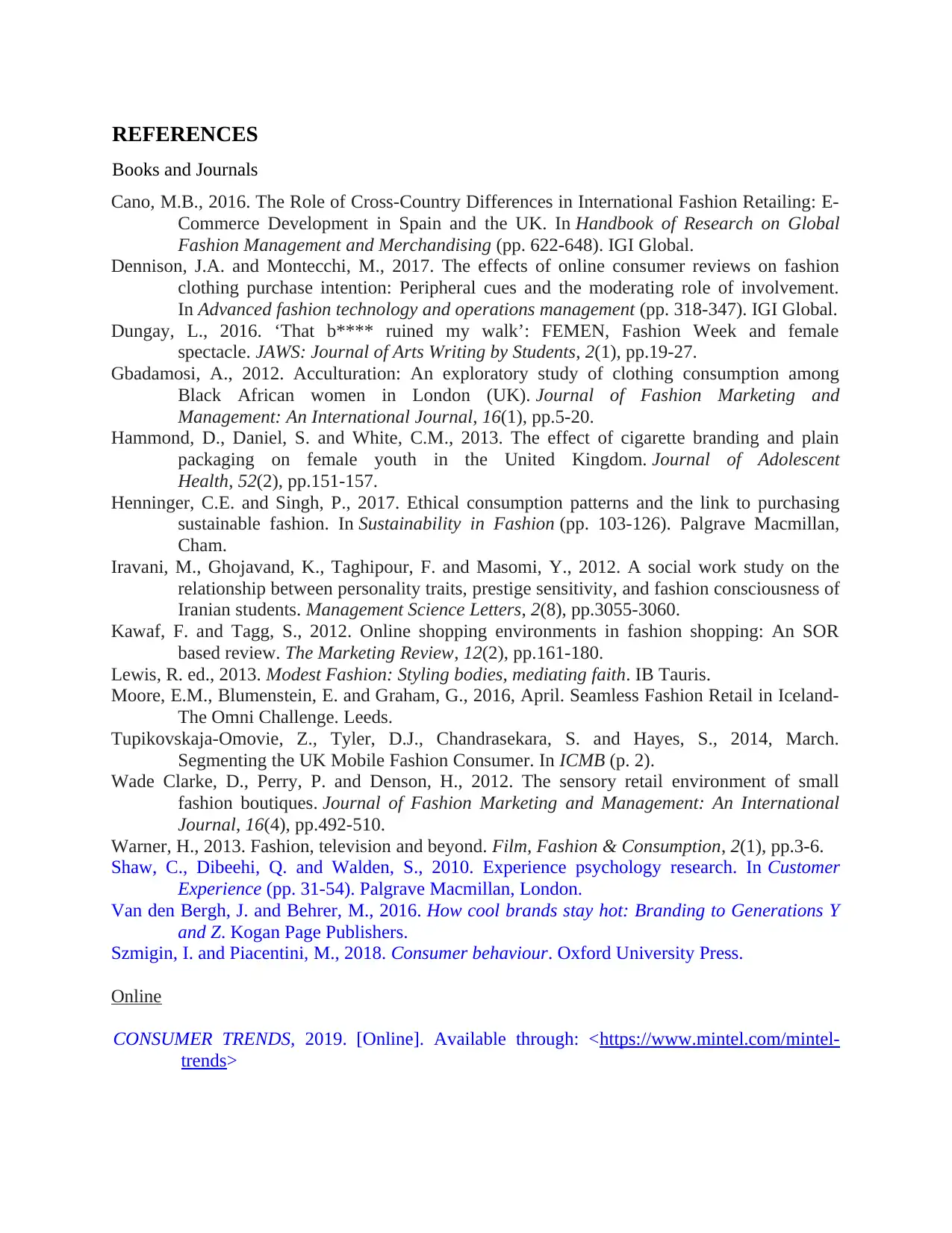
REFERENCES
Books and Journals
Cano, M.B., 2016. The Role of Cross-Country Differences in International Fashion Retailing: E-
Commerce Development in Spain and the UK. In Handbook of Research on Global
Fashion Management and Merchandising (pp. 622-648). IGI Global.
Dennison, J.A. and Montecchi, M., 2017. The effects of online consumer reviews on fashion
clothing purchase intention: Peripheral cues and the moderating role of involvement.
In Advanced fashion technology and operations management (pp. 318-347). IGI Global.
Dungay, L., 2016. ‘That b**** ruined my walk’: FEMEN, Fashion Week and female
spectacle. JAWS: Journal of Arts Writing by Students, 2(1), pp.19-27.
Gbadamosi, A., 2012. Acculturation: An exploratory study of clothing consumption among
Black African women in London (UK). Journal of Fashion Marketing and
Management: An International Journal, 16(1), pp.5-20.
Hammond, D., Daniel, S. and White, C.M., 2013. The effect of cigarette branding and plain
packaging on female youth in the United Kingdom. Journal of Adolescent
Health, 52(2), pp.151-157.
Henninger, C.E. and Singh, P., 2017. Ethical consumption patterns and the link to purchasing
sustainable fashion. In Sustainability in Fashion (pp. 103-126). Palgrave Macmillan,
Cham.
Iravani, M., Ghojavand, K., Taghipour, F. and Masomi, Y., 2012. A social work study on the
relationship between personality traits, prestige sensitivity, and fashion consciousness of
Iranian students. Management Science Letters, 2(8), pp.3055-3060.
Kawaf, F. and Tagg, S., 2012. Online shopping environments in fashion shopping: An SOR
based review. The Marketing Review, 12(2), pp.161-180.
Lewis, R. ed., 2013. Modest Fashion: Styling bodies, mediating faith. IB Tauris.
Moore, E.M., Blumenstein, E. and Graham, G., 2016, April. Seamless Fashion Retail in Iceland-
The Omni Challenge. Leeds.
Tupikovskaja-Omovie, Z., Tyler, D.J., Chandrasekara, S. and Hayes, S., 2014, March.
Segmenting the UK Mobile Fashion Consumer. In ICMB (p. 2).
Wade Clarke, D., Perry, P. and Denson, H., 2012. The sensory retail environment of small
fashion boutiques. Journal of Fashion Marketing and Management: An International
Journal, 16(4), pp.492-510.
Warner, H., 2013. Fashion, television and beyond. Film, Fashion & Consumption, 2(1), pp.3-6.
Shaw, C., Dibeehi, Q. and Walden, S., 2010. Experience psychology research. In Customer
Experience (pp. 31-54). Palgrave Macmillan, London.
Van den Bergh, J. and Behrer, M., 2016. How cool brands stay hot: Branding to Generations Y
and Z. Kogan Page Publishers.
Szmigin, I. and Piacentini, M., 2018. Consumer behaviour. Oxford University Press.
Online
CONSUMER TRENDS, 2019. [Online]. Available through: <https://www.mintel.com/mintel-
trends>
Books and Journals
Cano, M.B., 2016. The Role of Cross-Country Differences in International Fashion Retailing: E-
Commerce Development in Spain and the UK. In Handbook of Research on Global
Fashion Management and Merchandising (pp. 622-648). IGI Global.
Dennison, J.A. and Montecchi, M., 2017. The effects of online consumer reviews on fashion
clothing purchase intention: Peripheral cues and the moderating role of involvement.
In Advanced fashion technology and operations management (pp. 318-347). IGI Global.
Dungay, L., 2016. ‘That b**** ruined my walk’: FEMEN, Fashion Week and female
spectacle. JAWS: Journal of Arts Writing by Students, 2(1), pp.19-27.
Gbadamosi, A., 2012. Acculturation: An exploratory study of clothing consumption among
Black African women in London (UK). Journal of Fashion Marketing and
Management: An International Journal, 16(1), pp.5-20.
Hammond, D., Daniel, S. and White, C.M., 2013. The effect of cigarette branding and plain
packaging on female youth in the United Kingdom. Journal of Adolescent
Health, 52(2), pp.151-157.
Henninger, C.E. and Singh, P., 2017. Ethical consumption patterns and the link to purchasing
sustainable fashion. In Sustainability in Fashion (pp. 103-126). Palgrave Macmillan,
Cham.
Iravani, M., Ghojavand, K., Taghipour, F. and Masomi, Y., 2012. A social work study on the
relationship between personality traits, prestige sensitivity, and fashion consciousness of
Iranian students. Management Science Letters, 2(8), pp.3055-3060.
Kawaf, F. and Tagg, S., 2012. Online shopping environments in fashion shopping: An SOR
based review. The Marketing Review, 12(2), pp.161-180.
Lewis, R. ed., 2013. Modest Fashion: Styling bodies, mediating faith. IB Tauris.
Moore, E.M., Blumenstein, E. and Graham, G., 2016, April. Seamless Fashion Retail in Iceland-
The Omni Challenge. Leeds.
Tupikovskaja-Omovie, Z., Tyler, D.J., Chandrasekara, S. and Hayes, S., 2014, March.
Segmenting the UK Mobile Fashion Consumer. In ICMB (p. 2).
Wade Clarke, D., Perry, P. and Denson, H., 2012. The sensory retail environment of small
fashion boutiques. Journal of Fashion Marketing and Management: An International
Journal, 16(4), pp.492-510.
Warner, H., 2013. Fashion, television and beyond. Film, Fashion & Consumption, 2(1), pp.3-6.
Shaw, C., Dibeehi, Q. and Walden, S., 2010. Experience psychology research. In Customer
Experience (pp. 31-54). Palgrave Macmillan, London.
Van den Bergh, J. and Behrer, M., 2016. How cool brands stay hot: Branding to Generations Y
and Z. Kogan Page Publishers.
Szmigin, I. and Piacentini, M., 2018. Consumer behaviour. Oxford University Press.
Online
CONSUMER TRENDS, 2019. [Online]. Available through: <https://www.mintel.com/mintel-
trends>

10 Women’s Fashion Highlights To Celebrate London Fashion Week, 2019. [Online]. Available
through: <https://www.mintel.com/press-centre/fashion/strike-a-pose-10-womens-
fashion-highlights-to-celebrate-london-fashion-week>
through: <https://www.mintel.com/press-centre/fashion/strike-a-pose-10-womens-
fashion-highlights-to-celebrate-london-fashion-week>
⊘ This is a preview!⊘
Do you want full access?
Subscribe today to unlock all pages.

Trusted by 1+ million students worldwide
1 out of 12
Related Documents
Your All-in-One AI-Powered Toolkit for Academic Success.
+13062052269
info@desklib.com
Available 24*7 on WhatsApp / Email
![[object Object]](/_next/static/media/star-bottom.7253800d.svg)
Unlock your academic potential
Copyright © 2020–2025 A2Z Services. All Rights Reserved. Developed and managed by ZUCOL.




